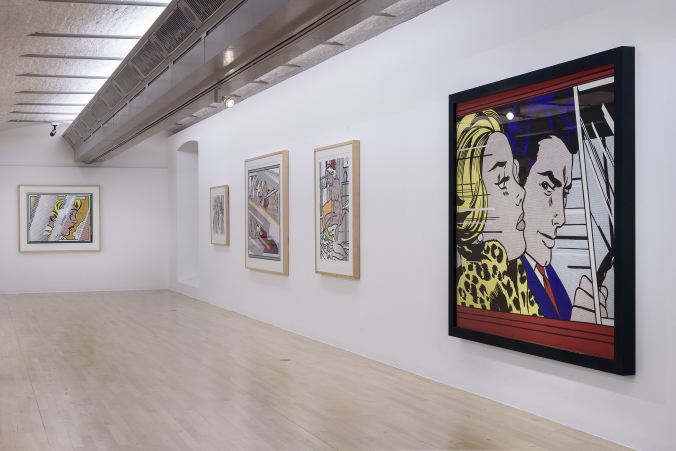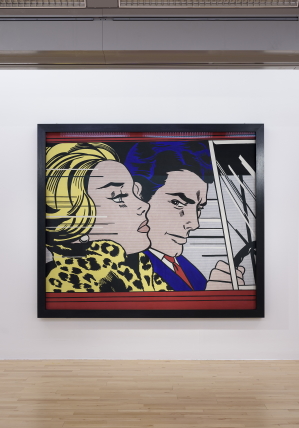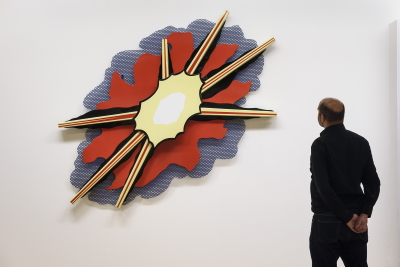Roy Lichtenstein at Tate Liverpool: a review
The comic-inspired work of artist Roy Lichtenstein was easy to love when I was a kid, but faced with a gallery filled with the stuff in 2017, I wondered whether my grown-up self would be quite so impressed. This review, originally written for the Northern Soul website, tells the full speech-bubbled tale – from the walls of my bedroom to the walls of Tate Liverpool.

A long time ago (the late 1970s) in a galaxy far, far away (Sheffield), I had a number of talismanic images on my bedroom wall.
There was a huge fold-out poster of R2D2 and C3PO, the stars of a much-hyped new movie. There was a picture of Roger Moore in The Spy Who Loved Me, a presence made more mysterious by the fact that I’d never seen a Bond film and didn’t see that one either. And there was a Pop Art birthday card featuring what appeared to be a frame from a comic. In the image, a uniformed American airman strode down a corridor, eyes fixed ahead.
“I am supposed to report to a Mr Bellamy,” he was thinking. “I wonder what he’s like.”
And that’s how Roy Lichtenstein entered my life.
I already knew the names of some artists. With an art teacher for a dad, it could hardly have been otherwise. But the likes of Picasso, Rembrandt and Van Gogh simply swirled around in an art historical soup in my head. I had no idea where they sat on art’s timeline, and I couldn’t have matched the artists to their work.
So it may be that Roy Lichtenstein, creator of that isolated comic-book frame on my bedroom wall, was the first fine artist I genuinely knew. And it’s easy to imagine why that would be. The language of Pop Art – a movement built on the appropriation and celebration of pop culture – was the language that kids in the 1970s all spoke.
Comics, advertising, bubblegum. This stuff was already our mother tongue.
With that in mind, it was fun to visit Tate Liverpool and take a look at the new display in their In Focus strand, a new exhibition devoted to Lichtenstein’s work over three decades. As with previous In Focus shows, the selection isn’t large – around 20 works in this case – but the bijou set-up allows visitors to enjoy a more manageable mouthful of art. Think of it as the Mars Fun-Size approach to curation compared to the full-length product that sometimes leaves you feeling over-faced.

Lichtenstein was almost 40 when he first began painting comic book images and mimicking the ‘Ben-Day dots’ that characterised the mechanical printing process. These are the tiny repeating dots that are used to create a range of colour and shading effects in certain types of printing, and which were characteristic of trashy American romance and war comics of the 1950s and 1960s.
Questions of authorship still hang over Lichtenstein’s work because he frequently ‘borrowed’ existing comic art, making only a few subtle tweaks to the original. In our age of sampling and remixing, however, we can at least acknowledge that in the selection, isolation and editing of the existing comic frames, Lichtenstein created new contexts for images that were mostly destined for the bin. After all, wasn’t the fine-artification of ‘throwaway’ mass media one of the conceptual touchstones at the heart of all Pop Art?
Roy Lichtenstein in Focus skips back and forth between the 1960s and the 1990s (he died in 1997), a neat mode of presentation that allows visitors to both appreciate his single-minded pursuit of a stylistic idea (those dots, speech bubbles and hard-edged black lines, all ever-present down the decades) while also noting the way his subject matter and methods changed.
It’s generally acknowledged that Lichtenstein first borrowed/appropriated/stole imagery from comics in 1961, but as early as the mid-1960s, he was already translating those cheap and cheerful printing methods into three optically tantalising dimensions. For instance, the exhibition includes Sunrise (1965), a wall-mounted construction that uses rippled, perforated steel to form the water and sky of a seascape. The layering and folding of the punched steel mimics the use of Ben-Day dots, but in this case they ebb and flow as you move around the room.
From the 1960s through to the 1990s, he was also playing art historical jokes with genres and styles, filtering movements such as Cubism through his stylistic gauze. In the screenprints Modern Art I and Modern Art II, both from 1996, he presents a sliced-up jumble of eyes and noses, ears and mouths, but rather than the dour motifs of a Picasso or Braque, these are glinting comic-book facial features, pouting perfectly even as they lay scattered across the frame.
Lichtenstein also made increasing use of reflections, both as a stylised graphic device and via the incorporation of gleaming metallic materials. In Reflections on Girl and Reflections on Conversation, both 1990, great lozenges of dot and shade lay across his trademark comic frames, breaking them up and obscuring the schmaltzy images that lie beneath. Anyone who has ever been troubled by reflections on paintings mounted behind glass will know the feeling, except this time, it’s all the artist’s own work.
However, in spite of this dogged stylisation and game playing, it seems to me that Lichtenstein was never as interesting in later years as he was in the 1960s, when the ideas were fresh and the methods seemed raw. There’s a glossiness to the later works that doesn’t seduce the viewer anything like as effectively as In the Car from 1963, with its silent couple bound for… who knows where? She stares fixedly ahead while he casts a potent glance at his companion. In their context-free silence, it seems clear that their evening promises chapters as yet unwritten.

Tate Liverpool regulars may cast their minds back to the excellent Transmitting Andy Warhol show three years ago, and wonder at the many layers of meaning that Warhol managed to strip from the modern world’s surface, still finding new ways to peel away at things up until his death in 1987. While it may be unfair to compare that major event with this small-scale show, the later Lichtensteins never truly seem to advance the artist’s original innovations.
So, given that Lichtenstein watched over me as I nodded off each night as a kid, and may have been the first ‘proper’ artist I loved, does his work still do it for me?
“Kind of” is the answer. Although the later comic-book renderings of water lillies and nudes can raise a wry smile, it’s the earlier work that contains mysteries of a specific time and place.
Along with In the Car, my favourite work here is the first piece you see when you enter. Sandwich and Soda (1964) is a modestly-sized two-colour screenprint that parodies the still-life paintings of olden-days art but replaces those mouldy old fishes and fruits with a sandwich and a big glass of pop.
Except “a sandwich and a big glass of pop” is not at all what they are. In spite of the graphic simplification and the mass-produced style, we can immediately see that this is not a potted-meat buttie with a dandelion and burdock accompaniment. This is bologna on rye, or a crustless BLT, while the unbranded drink must surely be Pepsi or Coke.
In short, it’s America on a plate, and that’s what I like about Lichtenstein. At their most poetic, his works are frozen cultural moments, and the likes of Sandwich and Soda offer a tingle of star-spangled seduction that, even in the late 1970s, seemed to emanate from a galaxy far away from my bedroom and me.

Text © Damon Fairclough 2017
Roy Lichtenstein In Focus ran at Tate Liverpool from 22 September 2017 until 17 June 2018.
Share this article
Follow me